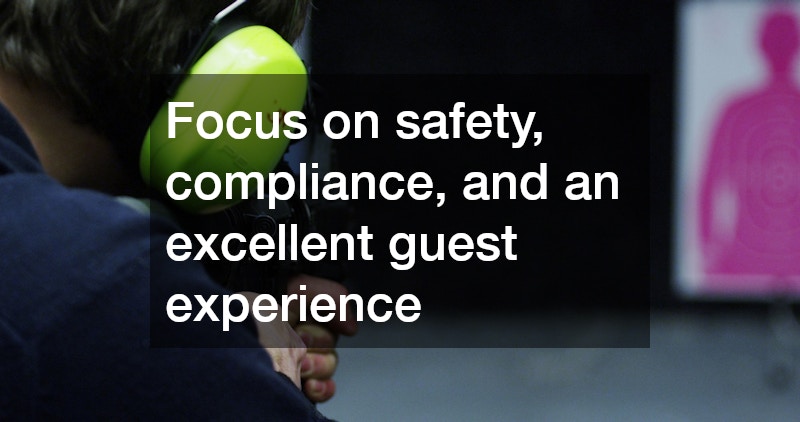Launching an indoor shooting range is part real estate, part engineering, and part hospitality. Success starts with a precise plan that aligns safety, compliance, and customer experience. You will be juggling zoning and permits, mechanical systems, staffing, and marketing, all while building trust with your community.
With thoughtful preparation and the right partners, you can create a safe, profitable venue that serves beginners, hobbyists, and professionals alike.
Define Your Market And Model
Clarify who you will serve and how you will price access. Decide between memberships, lane rentals, and corporate packages, then map peak hours and lane utilization targets. Outline your training ladder from 101 safety classes to advanced skills, and consider leagues or ladies’ nights to keep traffic steady. A clear model guides lane count, retail footprint, and staffing, which prevents costly redesigns later.
Location And Build Considerations
Start with zoning and noise ordinances, then evaluate access, parking, and proximity to compatible neighbors. The building itself needs serious infrastructure. Ventilation must move air downrange and out through proper filtration to control lead and combustion byproducts. Walls, baffles, and a rated bullet trap contain rounds and reduce ricochet risk, while acoustic treatments protect hearing and keep your neighbors happy. Operating an indoor shooting range also means planning for durable finishes, easy-to-clean surfaces, and ADA-compliant pathways that keep people moving safely.
Safety Systems And Standard Operating Procedures
Safety is a system, not a sign on the wall. Standard operating procedures should cover check-in, safety briefings, lane assignments, ammunition policies, cease-fire protocols, and emergency response. Range safety officers should be visible, proactive, and empowered to intervene. Invest in cameras with clear sight lines, first aid and bleed-control kits, and reliable communications. Consistent rules, friendly enforcement, and a culture of coaching make the environment welcoming while minimizing incidents.
Licensing And Insurance
Regulatory needs vary by city and state, so coordinate early with local authorities, your fire marshal, and code officials. If you plan to sell firearms or transfers, you will need the appropriate federal licensing, secure storage, and recordkeeping. Environmental responsibilities include lead management, waste handling, and worker exposure monitoring. Insurance should encompass general liability, property, workers’ compensation, professional instruction, and pollution liability. To license an indoor shooting range, you will also document construction specs, life-safety systems, and training programs that demonstrate due care.
People And Training
Hire for attitude, then train for skill. Look for instructors and range safety officers who communicate clearly, de-escalate gracefully, and model safe handling every minute. Ongoing staff drills, scenario walk-throughs, and customer service training keep standards high. Clear advancement paths reduce turnover, while predictable schedules and cross-training maintain coverage during peak hours. Running an indoor shooting range is a people business, so invest in team culture and recognition.
Revenue And Customer Experience
Think beyond lanes. Courses, private coaching, leagues, gift cards, and events diversify revenue. If permitted, retail sales of targets, eye and ear protection, apparel, and accessories add margin without large square footage. Streamline the guest journey with online booking, digital waivers, and self-serve kiosks at check-in. Clean restrooms, bright lighting, and comfortable waiting areas matter as much as target systems. Your indoor shooting range can also partner with local clubs, first responders, and businesses for group reservations that fill off-peak times.
Budget, Timeline, And Risk Controls
Build-outs require significant capital and patience. Create a phased budget that separates design, permitting, construction, equipment, and pre-opening marketing. Add contingencies for supply chain delays, inspections, and tuning mechanical systems. Before opening, run soft-launch sessions to test SOPs, calibrate airflows, and stress-test staffing levels. Maintain a maintenance schedule for traps, HVAC, target carriers, and PPE stocks so reliability stays high. Document everything, review incidents promptly, and update policies to close gaps.
Community Relations And Responsibility
A successful range is a good neighbor. Communicate early with nearby businesses and residents, share your safety commitments, and host open houses that explain how the facility operates. Offer beginner classes and family-friendly education to demystify the experience. Support local causes where appropriate, track noise and air quality carefully, and respond quickly to concerns. These efforts build long-term goodwill that protects your investment.
Opening this kind of facility is complex, but it is manageable with a disciplined plan. Focus on safety, compliance, and an excellent guest experience, and align your building systems with your business model from day one. With the right team and transparent operations, your indoor shooting range can become a respected, year-round destination that serves its community well.




